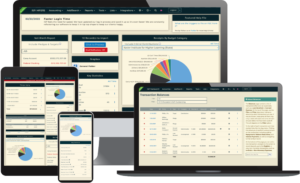Because the Post-Election Report date range has an election in the middle of the period, clients often get confused as to which Current Election to use and what date to supply as the Previous General Election Date when generating the report.
Our advice is:
- For the Previous General Election Date use an election date that corresponds to the Report From Date, rather than the election that happens during the period. You’ll want to ensure the Previous General Election Date is earlier than the Report From Date.
- However, for the Current Election use the election that happens during the report period.
After you generate your report and review the PDF, you may notice the summary pages for Lines 11 – 22 look pretty different. Typically there are two columns: Col A (Transactions in the Report) and Col B (Total of Transactions, Election Cycle To Date).
However, the report period for the Post-Election Report includes an Election, which the FEC uses to mark the end of an Election Cycle. This means the Post-Election Report covers two Election Cycles – the one that just ended at the Current Election, and the new one that started the day after the Current Election.
To accommodate this, the Post-Election has Column C, which is for that new second cycle. This column is the Total of Transactions Election Cycle to Date for the new cycle that started the day after the Current Election to the end of the report.
How do these columns work together?
- Column A: This column is always the total of transactions in the period and is the same, even on a Post-Election Report
- Column B: This column is always the total of transactions in the election cycle. For the FEC, an election cycle starts the day after the previous General election. We use the date provided in the Previous General Election Date
- Column C: This column is the total of transactions in the new election cycle, starting the day after the date of the election set as Current Election. This will include some transactions found in Column A
Is Column C only found on the Post-General Report?
Nope. In fact, Column C is found on 4 reports:
- Post-General Report: This is used in conjunction with a Pre-General Report, and filed after the General Election. This is the most common usage of the Column C
- Post-Special Report: This is used in conjunction with a Pre-Special Report, and filed after a Special Election
- Post-Runoff Report: This is used in conjunction with a Pre-Runoff Report, and filed after a Runoff Election
- Year-End with Column C: This is rarely used, and typically only per instruction by your FEC analyst. Using this reporting period will get Col C to reset the election cycle totals. This could be used if a candidate participated in the Primary Election, but did not continue on to the General Election
How do I do the math?
Typically, on reports with just Columns A and B, the math is:
Previous Report Column B +
Current Report Column A =
————————————
Current Report Column B
However, with the Post-Election, the math is:
Previous Report Column B +
Current Report Column A =
————————————
Current Report Column B +
Current Report Column C
Of course, it wouldn’t be the FEC if there wasn’t yet another strange thing on the report. On the first summary page (Lines 6-10), the Column B figures do not cover totals through the end of the report as they do for most reports; they only cover through the General (Current) Election. The FEC has stressed they care more about the Election Cycle totals, rather than the To Date totals.
Please also note Column C is only found on the Form 3. Form 3X Filers also have to file a Post-Election, but the 3X does not have this special summary page with Col C. The 3X To/From Dates will be the same, as well as Current Election and Report Period.






